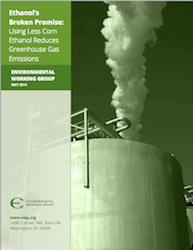A recent Environmental Work Group corn ethanol greenhouse gas report has caused lifecycle analysis experts and economist from Argonne National Laboratory and three universities to lash out and what they call “erroneous conclusions”.
The experts is sued a scathing 13-page response to EWG’s May report titled “Ethanol’s Broken Promise.” EWG “confused parameters” and “misunderstood” previous modeling results, according to experts from Argonne, North Carolina State University, Purdue University and University of Illinois-Chicago. “…based on an analysis of the methodology EWG used and a comparison of their results to those in the literature, from models, and from other data sets, EWG appears to have overestimated the amount of land converted for corn farming between 2008 and 2012. Second, EWG used emission factors that appear too high.”
sued a scathing 13-page response to EWG’s May report titled “Ethanol’s Broken Promise.” EWG “confused parameters” and “misunderstood” previous modeling results, according to experts from Argonne, North Carolina State University, Purdue University and University of Illinois-Chicago. “…based on an analysis of the methodology EWG used and a comparison of their results to those in the literature, from models, and from other data sets, EWG appears to have overestimated the amount of land converted for corn farming between 2008 and 2012. Second, EWG used emission factors that appear too high.”
More specifically, the experts found the following problems—among many others—with EWG’s report:
- “EWG confused parameters in GREET with those in an economic model, the Global Trade Analysis Project (GTAP).”
- “EWG misunderstood EPA’s GHG emissions for years 2012 and 2017.”
- “In their report, EWG picked the EPA 2012 GHG emissions for corn ethanol and applied them to the EPA-proposed reduced volume for corn ethanol in 2014 to make the erroneous conclusion that the proposal resulted in 3 million tonnes of CO2 reduction in 2014.”
- “…the emission factors they applied are high compared to those in other reports and studies that take into account important variations in initial and final land states.”
- The satellite data set used by EWG is “…explicitly not designed to be used for pixel-by-pixel or localized analyses.”
- The land use change data used by EWG is “…based on data that is decades old, reflecting wetland conversion over a much longer time horizon.”
- The report “…overestimated wetland conversion, especially for the conversion of wetlands to corn farms.” Wetlands and grasslands conversion estimates are “…too high when compared with estimates in other studies and data sources.”
The authors also point out that EWG is stuck in the past when it comes to lifecycle analysis. They write, “Since 2009, when EPA conducted corn ethanol LUC GHG modeling…, significant efforts have been made to improve economic models and soil carbon models to better estimate biofuel LUC GHG emissions. EPA and other federal agencies should consider updating RFS LUC modeling so that up-to-date LUC results can be used for biofuel policy making.”

